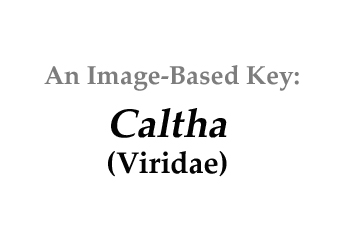|
Home / Anomalous_Items / Aquatic_Macrophytes / Emergent_Leaves / Caltha |
||||
|
|
||||
|
Click on images for larger format |
||||
Name derivation: |
||||
|
|
||||
Classification: |
||||
|
||||
|
||||
|
Example of diplophylly in Caltha obtuse, endemic in New Zealand (Weberling 1981) Flowers yellow, white or pink, 5-6 petals (Fassett 1940. Stem a rhizome with adventitious fibrous roots at periodic nodes. |
||||
Similar genera: |
||||
|
|
||||
Toxicity: |
||||
|
||||
|
||||
|
Based on chloroplast and nuclear DNA sequences, Caltha evolution and diversity began in the northern hemisphere and spread to the southern, probably through South America, followed by occupation Antarctica by middle Eocene (~49 mya) and eventually Australia and New Zealand (Schuettpelz and Hoot 2004). The southern hemisphere species have diplophylly (leaves with ‘double blades’), a kind of teratological leaf shape. Caltha palustris is a sulfide-sensitive species unable to oxidize the sulfide concentrations that develop in polluted sediments, so can be eliminated and replaced with less sensitive plants (e.g. Juncus effuses). Sufficient iron in the sediments creates a sulfide ‘trap’ (precipitate if FeS), conserving C. palustris (Van de Welle et al. 2006). |
||||
References: |
||||
|
Fassett, N.C. 1940. A Manual of Aquatic Plants. University of Wisconsin Press (404 pp.). Schuettpelz, E. and S.B. Hoot 2004. Phylogeny and biogeography of Caltha (Ranunculaceae) based on chloroplast and nuclear DNA sequences. American Journal of Botany 91*2):247-253. Smit, P.G. 1973. A revision of Caltha. Blumea 21: 119–150. Weberling, F. 1981. Morphologie der Blűten und der Blűtenstände. © Eugen Ulmer, Publisher. Van der Welle, M.E.W., K. Niggebrugge, L.P.M. Lamers, and J.G.M. Roelofs 2007. Differential responses of the freshwater wetland species Juncus effusus L. and Caltha palustris L. to iron supply in sulfidic environments. Environmental Pollution 147(1):222-230. |
||||





